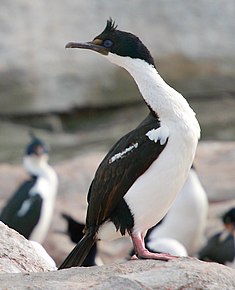Imperial shag
| Imperial shag | |
|---|---|
 |
|
| Scientific classification | |
| Kingdom: | Animalia |
| Phylum: | Chordata |
| Class: | Aves |
| Order: | Suliformes |
| Family: | Phalacrocoracidae |
| Genus: | Phalacrocorax |
| Species: | P. atriceps |
| Binomial name | |
|
Phalacrocorax atriceps (King, 1828) |
|
| Synonyms | |
|
|
The imperial shag (Phalacrocorax atriceps) is a black and white cormorant native to southern South America, primarily in rocky coastal regions, but locally also at large inland lakes. It is sometimes placed in the genus Leucocarbo. It is also known as the blue-eyed shag, blue-eyed cormorant and by many other names, and is one of a larger group of cormorants called blue-eyed shags. The taxonomy is very complex, and several former subspecies are often considered separate species.
The taxonomy is very complex and species-limits within this group remain unresolved. The following are considered part of this group:
While some authorities accept all of the above – except albiventer – as separate species, others consider all as subspecies of a single species (as done in this article). Alternatively, some recognize two species, the white-cheeked P. atriceps (with subspecies bransfieldensis, nivalis and georgianus) and the black-cheeked P. albiventer (with subspecies melanogenis and purpurascens), or it has been suggested that three species should be recognized: P. atriceps (including albiventer), P. georgianus (with subspecies bransfieldensis and nivalis), and P. melanogenis (with subspecies purpurascens and possibly verrucosus, though the latter is relatively distinctive, and most consider it a separate species, the Kerguelen shag).
The imperial shag has a total length of 70–79 cm (28–31 in) and weighs 1.8–3.5 kg (4.0–7.7 lb), with males averaging larger than females. It is endowed with glossy black feathers covering most of its body, with a white belly and neck. It possesses a distinctive ring of blue skin around its eyes, an orange-yellow nasal knob, pinkish legs and feet, and an erectile black crest. During the non-breeding season, adults lack the crest, have a duller facial area, and less/no white to the back/wings. It has a serrated bill used for catching fish.
The group varies primarily in the amount of white on the cheeks/ear-coverts, wing-coverts and back. Most taxa have white cheeks and ear-coverts, but these are black in albiventer, purpurascens and melanogenis. Chicks are uniform brownish, and immatures are brownish and white (instead of black and white), have dull facial skin, and lack the orange-yellow nasal knob and blue eye-ring.
...
Wikipedia

